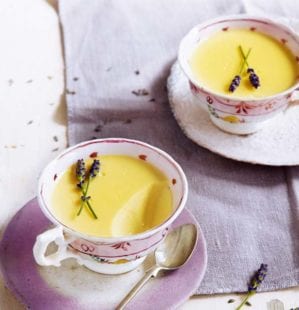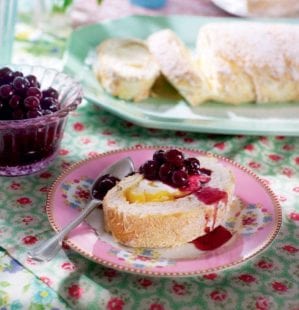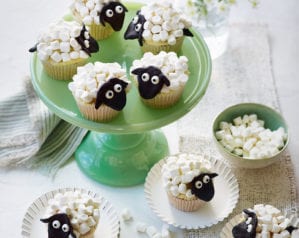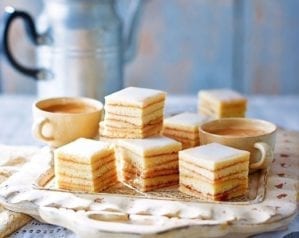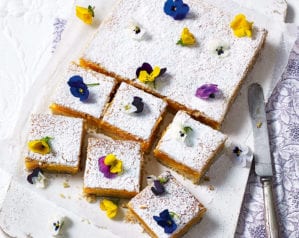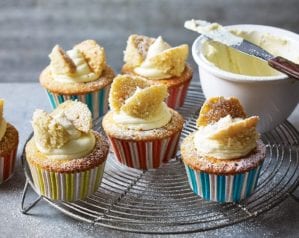
Lavender shortbread biscuits
- Published: 4 Apr 23
- Updated: 25 Mar 24
These beautiful lavender shortbread biscuits are made with lavender extract, which lends a delicate flavour and has a scent redolent of English country gardens. Gorgeous to look at, but even better to eat, you are going to love them!

For more lavender recipes, try our lemon and lavender possets or mini lavender cupcakes.
Ingredients
- 250g unsalted butter, cubed and softened
- 130g caster sugar, plus extra for decorating
- 250g plain flour, plus extra for dusting
- 125g rice flour
- 1/4 tsp salt
- 1/4 tsp natural lavender flavouring or extract (available from Castle Farm Shop)
- 2 tbsp milk, for brushing
- 4g pack edible flowers (available from Sainsbury’s and Ocado)
- Culinary lavender buds, for decoration (available from Castle Farm Shop, Sous Chef or Amazon)
Specialist kit
- 8cm round biscuit cutter with a smooth edge and 2 large, flat baking sheets, lined with compostable baking paper
Method
- Put the butter in a large mixing bowl with the caster sugar and mix with a wooden spoon until fully combined. Add both flours, salt and lavender extract and mix again to roughly bring together for a minute or so, then use your hands to briefly knead and bring the dough together. Shape into 2 fat discs, wrap then chill for around 1 hour until firm (see Make Ahead).
- Once firm, let the dough soften out of the fridge until pliable, about 10 minutes, then roll out one of the dough discs on a lightly floured surface until the dough is 0.5 cm thick. Stamp out as many rounds as you can, but don’t move them. Brush the tops of the dough circles with a very small amount of milk each, then carefully snip the stalks off the flowers as high as you can without making them fall apart – they need to lie on the biscuits as flat as possible. Gently press 2 or 3 into each round (you can pull some into petals to mix things up if you like), then scatter each biscuit with a few lavender buds.
- Once you’ve done all the biscuits, place a sheet of non-stick baking paper, big enough to cover the dough, over the top of the biscuits then gently roll your rolling pin back and forth over the biscuits a few times, so the flowers are pressed into the dough. Be careful – you should be aiming to keep the shape of the biscuits in the dough as much as you can. Remove the baking paper, then use the cutter to re-stamp the biscuit shapes out of the dough, and carefully transfer them to one of the baking sheets. Chill in the fridge for around 20 minutes while you do the next batch and heat the oven to 170C/ 150C fan/ gas 3 1/2.
- Re-roll the biscuit trimmings and repeat the process, using the second disc of dough once the first is too small to re-roll. Once the biscuits have chilled, bake for 15-20 minutes, until the shortbread is a uniform pale colour and the edges are crisping. Remove each batch from the oven and leave to cool on the baking sheet for 5 minutes, before carefully transferring to a wire rack to cool completely. Scatter with caster sugar, if you like, then either serve immediately, or box up until needed.
- Recipe from July 2020 Issue
Nutrition
- Calories
- 155kcals
- Fat
- 8.8g (5.5g saturated)
- Protein
- 1.4g
- Carbohydrates
- 18.4g (5.9g sugars)
- Fibre
- 0.6g
delicious. tips
These biscuits are cooked to be slightly softer than traditional shortbread, so the flowers don’t burn in the oven. If you want to leave off the flowers and make the shortbread properly crisp, bake for 5-8 minutes longer than in the recipe, until the biscuits are pale golden.
The biscuits are best on the day they’re made but will keep in an airtight container for up to 4 days. The unbaked dough can be tightly wrapped and frozen for up to 2 months, defrost to slice and bake.
Almost all lavender can be used in the kitchen as long as it’s been grown without the use of chemicals. The most common are the group known as the English lavenders – lavandula angustifola, to give them their proper name. These are probably the first ones you think of when you picture lavender plants: long grey-green stems with slender flower heads on top.
You can buy culinary lavender buds, but they’re easy to make at home if you have the plants in your garden. Snip the stems at the height of their bloom, tie together and hang upside down inside for a week or two until dried out, then carefully pull off the buds and store in airtight jars. You can use the fresh heads straight off the plants in salads or to decorate cakes and drinks, but drying them gives a more fragrant flavour and a better texture to eat. If you’re lucky enough to be able to dry your own that’s great, but if not it’s easy to get your hands on these lavender products.
Buy ingredients online
Rate & review
Rate
Reviews
Subscribe to our magazine
Food stories, skills and tested recipes, straight to your door... Enjoy 5 issues for just £5 with our special introductory offer.
Subscribe
Unleash your inner chef
Looking for inspiration? Receive the latest recipes with our newsletter


